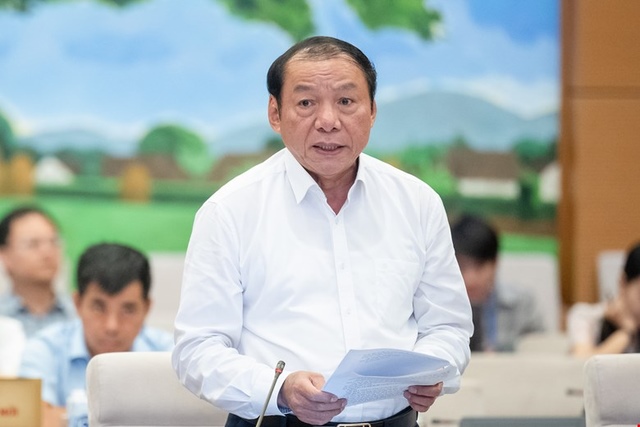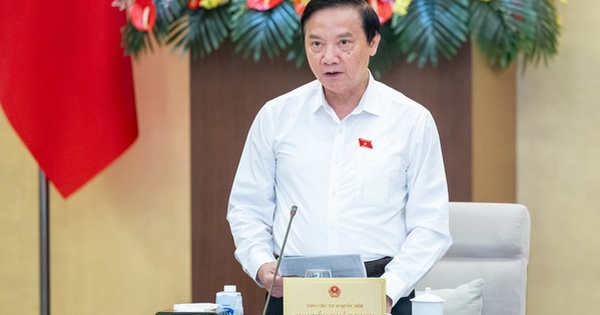On the morning of May 14, the National Assembly’s Standing Committee (NA) discussed and gave opinions on the proposal on the master plan for investing in the National Target Program (NTP) on cultural development for the period of 2025-2035.

Minister of Culture, Sports and Tourism Nguyen Van Hung presents the proposal. Photo: Pham Thang |
Presenting the proposal, Minister of Culture, Sports and Tourism (MCST) Nguyen Van Hung stated that there are seven beneficiaries of the program, including: People and communities across the country; Overseas Vietnamese; Artists, intellectuals, and human resources in the field of culture; Enterprises, organizations, and individuals operating in the field of culture and arts; World cultural heritages, special national relics, and national relics.
The program is planned to be implemented over a period of 11 years, from 2025 to 2035, and is divided into three phases. In 2025, the focus will be on developing mechanisms and policies, as well as guidelines for implementing the tasks of the program, along with monitoring and evaluation systems. This year will also involve training and capacity building for program management staff, and preparation for investment in other tasks and management contents.
The second phase, from 2026 to 2030, will focus on addressing limitations and challenges faced in the previous period, and on implementing the goals and tasks set for 2030. The final phase, from 2031 to 2035, will continue to develop culture as an endogenous strength of the Vietnamese economy, and will work towards achieving the tasks and goals set for 2035.
By 2030, the program aims to achieve nine specific targets, including: 100% of provincial-level administrative units having three types of cultural institutions, and 80% of district-level administrative units having Cultural-Sports Centers meeting the standards; At least 95% of special national relics and about 70% of national relics will be restored and upgraded; Striving for the cultural industries to contribute to 7% of the country’s GDP…
According to the proposal, the MCST will be the agency in charge of managing and monitoring the overall implementation of the program throughout the country.
On behalf of the verifying agency, Mr. Nguyen Dac Vinh, Chairman of the National Assembly’s Committee for Culture, Education, Youth, and Children, stated that the program has a wide range of targets and scopes, with many difficult and diverse contents. He emphasized the need for thorough research and comprehensive evaluation before the National Assembly decides on the investment policy. Therefore, he suggested that the National Assembly consider and decide on the proposal through a two-session process, with the first discussion taking place at the 7th session and the final approval at the 8th session of the 15th National Assembly.
Agreeing with the necessity to issue the NTP on cultural development for the period of 2025-2035, Mr. Nguyen Khac Dinh, Vice Chairman of the National Assembly, emphasized the importance of the cultural industry as a significant trend of the times. He noted that the government’s proposal includes many fields such as cultural and artistic activities, heritage, grassroots culture, performing arts, fine arts, photography, exhibitions, cinema, and finally, the cultural industry. However, he suggested a review and revision to ensure specificity and avoid overlap, as the cultural industry already encompasses some of the mentioned fields.
 Vice Chairman of the National Assembly, Mr. Nguyen Khac Dinh, suggested paying special attention to the field of cultural industry. Photo: Pham Thang |
Mr. Dinh emphasized the need to pay special attention to the field of cultural industry, as it has become a significant driver of economic, cultural, and social development worldwide. He noted that many countries have recognized the importance of the cultural industry, not only for economic growth but also for cultural exchange and international integration. Vietnam possesses numerous potentials and advantages in this field, and it is essential to capitalize on them.
The strategy for developing Vietnam’s cultural industries during the period of 2020-2030 also emphasizes the view that cultural industries are an essential part of the national economy, contributing to both cultural and economic development.
“For a long time, we have understood culture as a sector that spends money, but in today’s world, it is a sector that generates significant revenue and has a very high added value,” said Vice Chairman Dinh.
He provided examples to illustrate his point, such as a group of South Korean female singers performing in Vietnam for a few nights, earning as much as a Vietnamese enterprise would in several months, or the global popularity of the song ‘Gangnam Style’ by a South Korean singer. He also mentioned the case of Mr. Park Hang-seo, who was honored for his contribution to cultural exchange between Vietnam and South Korea.
“These examples from the new era highlight the potential of the cultural industry, which can bring enormous profits. The state does not need to invest heavily in this sector but rather create favorable conditions for its development,” said Vice Chairman Dinh.
B.H.Thanh




![[Photo Essay]: Experts, Managers, and Businesses Unite to Forge a Path Towards Sustainable Green Industry](https://xe.today/wp-content/uploads/2025/07/z678592918-150x150.jpg)


![[Photo Essay]: Experts, Managers, and Businesses Unite to Forge a Path Towards Sustainable Green Industry](https://xe.today/wp-content/uploads/2025/07/z678592918-100x70.jpg)




